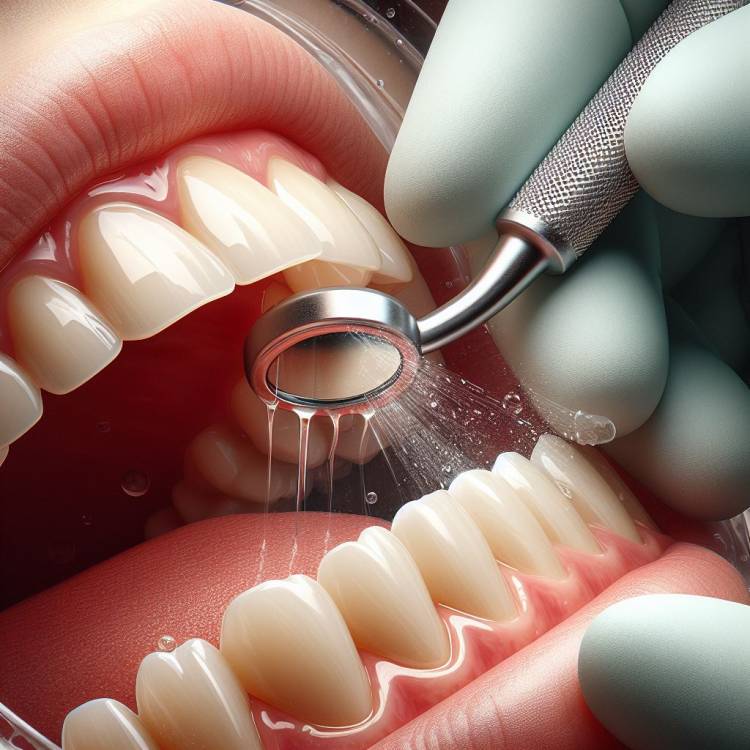Gum disease, or periodontitis, has long been recognized as a potential threat to oral health. However, recent research is shedding light on a broader perspective, suggesting that a primary culprit associated with periodontitis, Porphyromonas gingivalis, may be at the root of various systemic diseases. The paper “Porphyromonas gingivalis and Its Systemic Impact: Current Status” provides a comprehensive update on the links between P. gingivalis and conditions such as atherosclerosis, Alzheimer’s disease, and certain cancers.

Understanding the Research
Unlike previous studies that focused on the connection between P. gingivalis and specific diseases, this investigation takes a more holistic approach. It aims to unravel the intricate relationship between this pathogen and a range of systemic diseases. The research delves into the internal mechanisms that might be associated with this connection, offering a more complete understanding of the impact of P. gingivalis on our overall health.
Implications for Chronic Conditions
The implications of Porphyromonas gingivalis (P. gingivalis) in chronic conditions extend beyond what was initially suspected. While previous studies suggested its involvement in chronic conditions such as Type 2 diabetes and cancer, the current review delves deeper into the intricate web of connections between P. gingivalis and an array of health issues. This reveals a more complex relationship that underscores the systemic impact of oral health.
Myocardial Infarction:
P. gingivalis is now linked to myocardial infarction, commonly known as a heart attack. This revelation emphasizes the broader cardiovascular implications of gum disease, highlighting the need for holistic approaches to both oral and heart health.
Hypertension:
The association between P. gingivalis and hypertension brings attention to the potential role of gum disease in contributing to high blood pressure. Understanding this link may prompt more comprehensive healthcare strategies addressing both oral hygiene and blood pressure management.
Abdominal Aortic Aneurysms:
The link to abdominal aortic aneurysms suggests that P. gingivalis might play a role in the weakening of the aorta. This finding adds a vascular dimension to the systemic impact of poor gum health.
Pancreatic and Esophageal Cancer:
The association with pancreatic and esophageal cancer expands the spectrum of potential consequences of untreated gum disease. It highlights the importance of oral health in the broader context of cancer prevention.
Oral Squamous Cell Carcinoma:
The direct link to oral squamous cell carcinoma reaffirms the connection between chronic oral inflammation and the development of cancer within the oral cavity. This emphasizes the critical role of proactive dental care in cancer risk reduction.
Chronic Obstructive Pulmonary Disease (COPD):
The association with COPD draws attention to the potential respiratory consequences of untreated gum disease. It underscores the need for a comprehensive understanding of oral health’s impact on the respiratory system.
Nonalcoholic Fatty Liver Disease:
P. gingivalis is now implicated in nonalcoholic fatty liver disease, connecting poor oral health to liver health. This finding emphasizes the intricate links between seemingly unrelated parts of the body.
Respiratory Diseases like Pneumonia:
The connection to respiratory diseases, including pneumonia, emphasizes the far-reaching consequences of gum disease on the respiratory system. It underscores the importance of maintaining good oral health for overall respiratory well-being.

The Road to a Healthier Future
The pursuit of a vaccine against Porphyromonas gingivalis (P. gingivalis) represents a significant stride toward a healthier future, marking a potential turning point in the landscape of oral and systemic health. As research uncovers the intricate connections between P. gingivalis and a myriad of systemic diseases, the development of a vaccine emerges as a promising avenue with far-reaching implications.
Comprehensive Protection:
A successful vaccine against P. gingivalis holds the promise of providing comprehensive protection against gum disease. By targeting the principal pathogen associated with periodontitis, the vaccine could act as a proactive shield, preventing the onset and progression of gum disease.
Preventing Systemic Complications:
Beyond its impact on oral health, the implications of a P. gingivalis vaccine extend to preventing systemic complications linked to the pathogen. If successful, the vaccine could potentially disrupt the chain of events connecting gum disease to conditions such as cardiovascular diseases, certain cancers, and respiratory issues.
Revolutionizing Oral Care:
The development of a vaccine has the potential to revolutionize the field of oral care. It could shift the paradigm from reactive treatments to proactive prevention, offering individuals a tool to fortify their immune systems against the specific threat posed by P. gingivalis.
Reducing Healthcare Burden:
By preventing the onset of gum disease and its systemic consequences, a P. gingivalis vaccine could contribute to reducing the overall burden on healthcare systems. This proactive approach may lead to fewer cases of chronic diseases, translating into lower healthcare costs and improved public health.
Enhancing Quality of Life:
Successful vaccination against P. gingivalis could significantly enhance the quality of life for individuals. By minimizing the risk of chronic conditions associated with gum disease, people may experience improved overall health, well-being, and longevity.
Integrating Oral and Systemic Health:
The vaccine’s success would underscore the integral connection between oral and systemic health. It emphasizes that addressing the root cause of oral health issues can have widespread positive effects on overall well-being, emphasizing the importance of an integrated healthcare approach.
Global Public Health Impact:
On a global scale, the development and widespread implementation of a P. gingivalis vaccine could have a profound impact on public health. It may contribute to reducing the global prevalence of chronic diseases and enhance health outcomes for populations worldwide.
Shaping Future Healthcare Strategies:
The successful development of a P. gingivalis vaccine could reshape future healthcare strategies. It may prompt a shift towards preventive dentistry, with a focus on immunization as a fundamental aspect of oral health maintenance.
Connecting Oral and Systemic Health
The intricate connections between oral health and overall well-being highlighted by the research on Porphyromonas gingivalis (P. gingivalis) underscore the profound impact that oral conditions can have on the entire body. This comprehensive understanding of the link between P. gingivalis and systemic diseases emphasizes the critical importance of proactive oral care in preventing not only gum disease but also potential systemic complications.
Oral-Systemic Axis:
The research illuminates the existence of an oral-systemic axis, a dynamic relationship where the health of the mouth influences the health of the entire body. This emphasizes that the mouth is not isolated but intricately connected to systemic health.
Inflammation as a Common Denominator
One key factor in this connection is inflammation. Chronic oral inflammation, as seen in conditions like gum disease, can act as a common denominator that contributes to the development and exacerbation of systemic diseases. This underscores the need to address inflammation at its source – in the mouth.
Bridging the Gap:
Understanding the link between P. gingivalis and systemic diseases helps bridge the gap between traditionally separate fields of dentistry and medicine. It prompts a more holistic approach to healthcare, where oral health is recognized as a vital component of overall well-being.
Preventing Systemic Complications:
Proactive oral care becomes a crucial element in preventing not only gum disease but also potential systemic complications. By maintaining optimal oral health, individuals can reduce the risk of chronic conditions that may have systemic consequences, such as cardiovascular diseases and certain cancers.
Shared Risk Factors:
Both oral and systemic diseases often share common risk factors, such as poor diet, tobacco use, and inadequate oral hygiene. Addressing these risk factors not only benefits oral health but also positively influences systemic health, creating a symbiotic relationship between preventive measures.
Health Promotion and Disease Prevention:
The link between oral and systemic health underscores the role of dentists and healthcare providers as promoters of overall health and disease prevention. Encouraging patients to prioritize oral health becomes a strategy for promoting a healthier lifestyle and reducing the overall risk of chronic diseases.
Patient Empowerment:
Empowering individuals with the knowledge of the oral-systemic connection allows them to actively participate in their health. Patients who understand the potential consequences of poor oral health are more likely to engage in preventive practices and seek timely dental care.
Holistic Healthcare Strategies:
The research calls for a shift towards holistic healthcare strategies that integrate oral health into routine medical care. Dentists, physicians, and other healthcare professionals working collaboratively can provide more comprehensive and effective care for patients.
Long-Term Health Outcomes:
Recognizing and addressing the link between P. gingivalis and systemic diseases can have long-term implications for health outcomes. Proactive oral care, coupled with a broader understanding of the oral-systemic axis, may contribute to improved quality of life and longevity.
Summing Up!
The connection between gum disease and systemic health becomes increasingly apparent. The research on Porphyromonas gingivalis opens new doors for preventive measures and treatments that could transform the landscape of both oral and systemic health. The ongoing work on a vaccine signifies a step towards a healthier future, where the dots between gum disease and systemic health are not just connected but actively addressed for the well-being of individuals worldwide.
FAQs
What is Porphyromonas gingivalis, and how is it related to gum disease?
Porphyromonas gingivalis is a bacteria associated with periodontitis, a severe form of gum disease. It plays a significant role in the development and progression of gum disease.
How does gum disease impact systemic health?
Gum disease is linked to various systemic conditions, including cardiovascular diseases, certain cancers, and respiratory issues. The inflammation associated with gum disease can contribute to systemic complications.
What are the potential consequences of untreated gum disease?
Untreated gum disease can lead to tooth loss, chronic inflammation, and an increased risk of systemic diseases. It may also impact overall well-being and quality of life.
Why is there a focus on developing a vaccine against Porphyromonas gingivalis?
A vaccine against Porphyromonas gingivalis aims to prevent gum disease by targeting the bacteria responsible. Its development holds the potential to revolutionize oral and systemic health by offering a proactive approach to prevention.
How does the research connect oral health to overall well-being?
The research highlights an intricate connection between oral health and overall well-being, emphasizing that what happens in the mouth can have far-reaching effects on the rest of the body.
What are the common risk factors for both oral and systemic diseases?
Poor diet, tobacco use, and inadequate oral hygiene are common risk factors for both oral and systemic diseases. Addressing these factors can positively influence both oral and overall health.
How can individuals proactively care for their oral health to prevent systemic complications?
Proactive oral care involves maintaining good oral hygiene practices, adopting a healthy diet, and seeking regular dental check-ups. These measures can help prevent not only gum disease but also potential systemic complications.
What role does inflammation play in the oral-systemic connection?
Chronic oral inflammation, often seen in gum disease, acts as a common denominator that contributes to systemic diseases. Addressing inflammation in the mouth becomes crucial in preventing systemic complications.
How can healthcare providers bridge the gap between oral and systemic health in patient care?
Healthcare providers can bridge the gap by recognizing the oral-systemic connection and integrating oral health into routine medical care. Collaboration between dentists and physicians is essential for comprehensive patient care.
What are the long-term implications of understanding the link between Porphyromonas gingivalis and systemic diseases?
Understanding this link can lead to improved health outcomes, a shift towards holistic healthcare strategies, and the empowerment of individuals to actively participate in their health for long-term well-being.
Address: PRISTINE SMILES DENTAL CARE
1, Jayanti Niwas, opp. Vaishali Hotel,
Near Iskcon Temple,Jukarwadi,
Juhu, Mumbai, Maharashtra 400049
